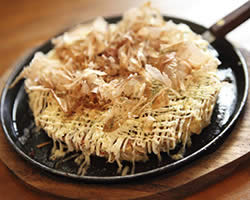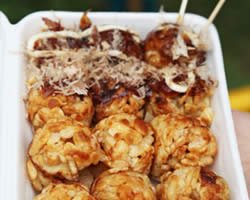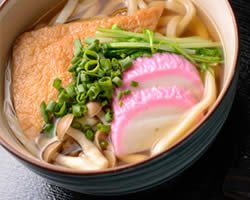The dashi is an essential basic broth in many Japanese recipes such as miso soup, okonomiyaki, takoyaki…
- Dashi, Japanese broth
- How to make dashi
- Dashi, a taste enhancer
- The different types of dashi
- Dashi in Japanese cuisine
Dashi, Japanese broth
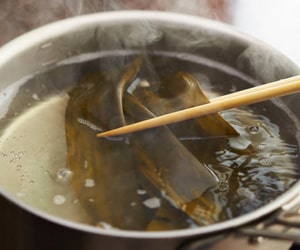 The most classic dashi “だし” is a broth of konbu “こんぶ” and dried bonito shavings called Katusobushi “鰹節” (bonito is a fish of the Scombridae family, a cousin of tuna).
The most classic dashi “だし” is a broth of konbu “こんぶ” and dried bonito shavings called Katusobushi “鰹節” (bonito is a fish of the Scombridae family, a cousin of tuna).
There are indeed other types of dashi that we will see later.
We find notably the dashi in miso soup. It is a basic broth in the Japanese cuisine which is used in many recipes.
How to make dashi
1 This broth is made by soaking the konbu for a few hours (at least two) in pure fresh water.
2 Then put the pan on a low heat and turn off the heat just before boiling.
3 Take out the konbu seaweed and then add the dried bonito flakes.
4 When the dried bonito flakes start to fall to the bottom of the water remove them and let the dashi rest at room temperature.

Katsuobushi

Fresh Konbu

Konbu dried
You will be able to prepare many dishes with this broth. Soups, noodles, cooking vegetables, meat or even fish.
For maximum flavor, leave the konbu in the water overnight. Be careful however during the cooking never boil the water! The broth would then be much less good.
Unfortunately these ingredients are quite expensive and not necessarily easy to find. There is therefore already ready dehydrated dashi in granulated form. This one is very widespread in Japan. Rare are those who still prepare their own dashi.
Dashi, a taste enhancer
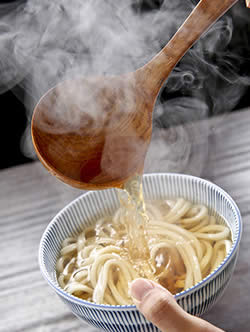 To talk about the properties of dashi, we will have to talk about the umami flavor “うまみ”. Umami is one of the five known flavors, namely sweet, salty, bitter, sour and umami.
To talk about the properties of dashi, we will have to talk about the umami flavor “うまみ”. Umami is one of the five known flavors, namely sweet, salty, bitter, sour and umami.
But then, what does umami taste like? In reality it is not really a particular taste but a rather incredible property, that of making the flavors of the associated foods more pleasant and more balanced in the mouth. You go from a bland dish to a delicious dish with the addition of umami.
But then where is this umami? In reality many foods naturally contain more or less umami. Where it becomes interesting is that the umami taste of one food is added to that of another. The dish then has a very powerful taste with complex aromas in the mouth.
And dashi is exactly that. All the ingredients in dashi contain a very high level of umami and they are complementary. So dashi naturally has the property of making all your soups, your preparations, your sauces wonderfully good. Many large tables are seriously considering this little broth.
The different types of dashi
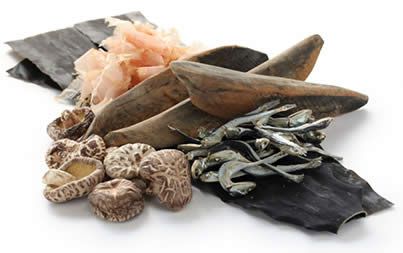 There are different combinations of dashi but the ingredients are counted on the fingers of one hand. Bonito, konbu, dried shiitake “椎茸” (Japanese mushrooms) and niboshi “煮干し” are small dried sardines used as a base for dashi and many other dishes all over Asia).
There are different combinations of dashi but the ingredients are counted on the fingers of one hand. Bonito, konbu, dried shiitake “椎茸” (Japanese mushrooms) and niboshi “煮干し” are small dried sardines used as a base for dashi and many other dishes all over Asia).
But it’s not a question of putting everything in the water just anyhow. There are combinations to be respected so that this broth is tasty.
Here are some simple versions of the broth:
- The konbu dashi, is made only by soaking konbu in water.
- Shiitake dashi uses only dried mushrooms.
The niboshi dashi is a broth using only small sardines gutted, dried and whose head has been removed.
Here are other examples, this time combining the above elements:
- Ichiban dashi, is obtained by soaking konbu and dried bonito (this is the one we saw earlier in the article). It is really delicious.
- Niban dashi: is made in the same way as ichiban dashi and with the remains of it. The flavors are thus more full-bodied.
- Shojin dashi is cooked from dried shiitake mushrooms and konbu seaweed.
Dashi in Japanese cuisine
You will have understood it, the dashi is an essential base in many Japanese recipes. Its use is not limited to various sauces and broths, it is found for example in the composition of okonomiyaki, takoyaki or kakutako paste for example. The preparation then immediately takes on a typically Japanese taste.
Here are some examples of Japanese dishes using dashi :
